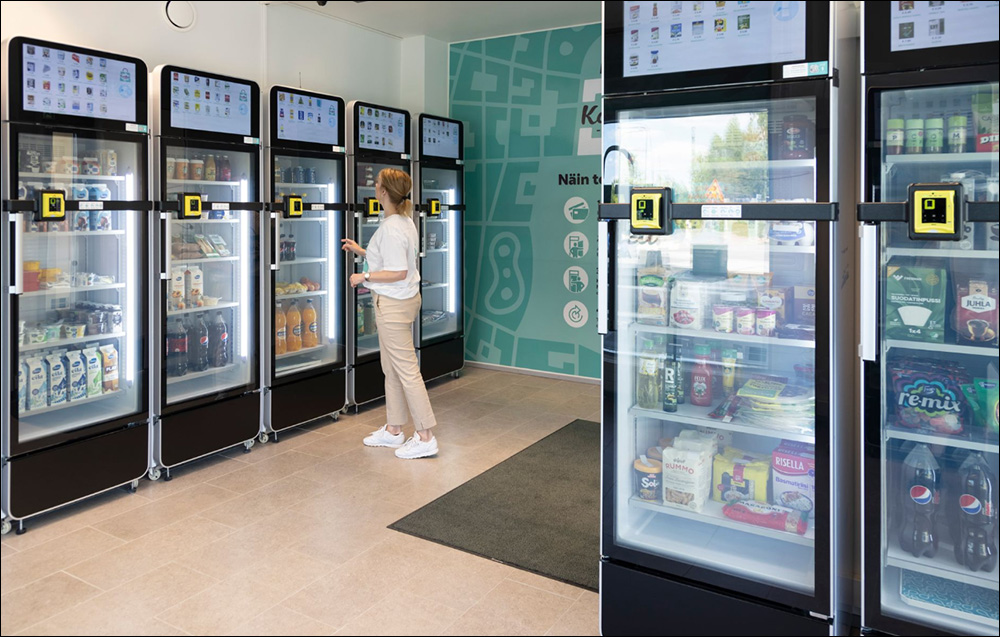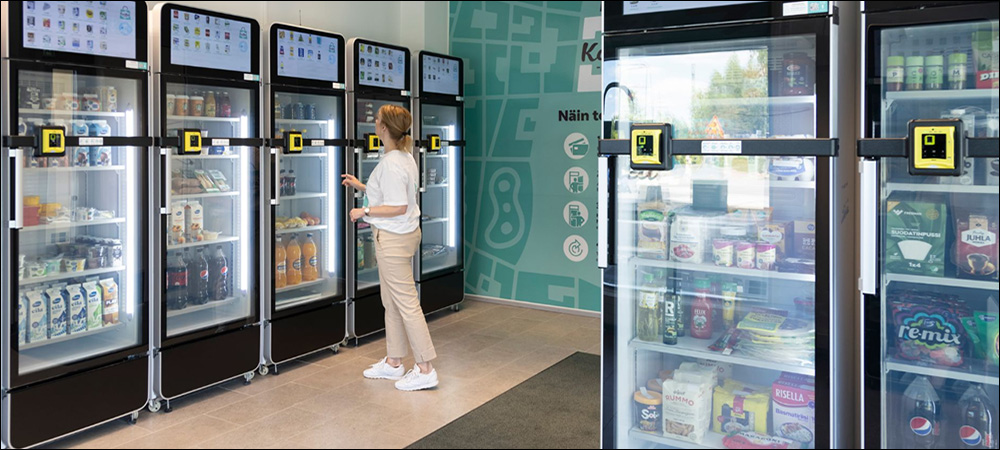- Tracking Goods from the Warehouse
- Open for Business 24 Hours a Day
- Saving Costs and Gaining Sustainability
Finnish technology company Blockstore Group is working with grocery retailers to open unmanned markets that provide shoppers with walk-in, walk-out service. The system leverages UHF RFID technology to identify goods, track inventory from the warehouse, and enable customer purchases and inventory replenishment. While the project began with a half-dozen concept stores, a full-sized grocery store opens this summer in Helsinki, with more to follow. “All our stores are in the Helsinki metropolitan area,” says Juha Maijala, Blockstore Group’s CEO. “Currently, we are finalizing our newest store that has space for over 1,000 SKUs [stock-keeping units].”
Blockstore won an RFID Journal Award for Best Use of RFID to Enhance a Product or Service at this year’s RFID Journal LIVE! conference and exhibition, held in Las Vegas. The company is now scaling its solution by not only opening new stores, but also adding SKUs within these much larger sites. Blockstore will work with a variety of retailers in the grocery market, with an initial focus on Europe. Its long-term plan is to open stores in North America as well.
The solution consists of unmanned markets in residential neighborhoods. Each shop comes with Stora Enso‘s Selfly Store cabinets, in which RFID-tagged merchandise is displayed, along with an RFID cabinet reader system. The readers built into the cabinets capture the unique ID numbers of all products, then store the inventory data in the retailer software. Data is managed on Blockster, Blockstore’s cloud-based technology platform. The system was designed to offer convenience for customers who have grown accustomed to shopping online or having goods delivered to their homes.
Retailers have been challenged to adapt to the needs of these shoppers, Maijala says. “Many residential area stores have been closed down,” he says, though there are self-checkout options in some locations. Retailers offer a variety of technology-based systems for “frictionless checkout,” such as the Amazon Fresh system, as well as computer vision solutions from Aifi and Trigo Retail, but the Blockstore Group chose a different approach leveraging RFID technology to track every unique product from distribution center to store to consumer.

The system was designed to offer convenience for customers who have grown accustomed to shopping online or having goods delivered to their homes.
Tracking Goods from the Warehouse
With the Blockstore system, tags are applied to goods at the warehouse before being transported to stores. Readers are installed at warehouse sites to encode and read tags, thus beginning each product’s digital trail. In that way, the RFID tags can manage supply chain data as goods leave the warehouse for the store and are then received at that location. Standard grocery products, such as dairy, cheese, bread, meat, seafood, vegetables, soap, breakfast food, pasta, rice and candy, as well as “grab and go” lunches and snacks, are all sold at such stores.
The company employs a combination of Beontag ECO RFID tags and Avery Dennison Smartrac RFID tags to uniquely identify each piece of merchandise. Once items are received at the store, they can be placed in the cabinets that display goods for sale, which shoppers can access. The Selfly Store IF 2.1 cabinets come with built-in readers and antennas that capture each tag’s unique ID as items are placed on shelves.
Each store comes with other sensor technologies as well, including motion and character-recognition sensors at the entrance, and Blockstore Group offers an automation platform that manages the collected supply chain data. In this way, Maijala explains, “We have achieved [an] exceptionally smooth consumer journey.”
Open for Business 24 Hours a Day
Shoppers can shop at the store with or without an app. Those who download an app on their smartphone can link a credit card number or other payment information with their account and phone. They can open the app upon arrival, or the store’s technology can automatically send a notification welcoming them to the site based on their GPS location, and they can then confirm they would like to shop and select a payment method. The character-recognition technology confirms each consumer’s identification.

Juha Maijala
A payment terminal is dedicated to those not using the app. They would provide their card to the terminal, enter their PIN and then proceed with shopping. In either scenario, visitors can use the store seven days a week, 24 hours a day. A motion detector identifies that they are inside the store, in addition to which cabinets or coolers they approach. Shoppers can open the cabinet doors and select the products they want. Once they close the doors, the Selfly Store RFID reader updates the inventory data to indicate which items have been removed. A small screen on the door confirms what has been placed in their shopping cart, and this information is then displayed in the phone app on their virtual basket.
Once they are finished, shoppers can simply walk out the door, and the total cost will be deducted from their account automatically. “The receipt of the shopping is in the app,” Maijala says, “or alternatively it can be printed out in the payment terminal at the store exit.” While the system could initially accommodate one shopper at a time, the larger new store can serve up to 20 customers onsite at a time. The Blockster platform includes functionality for store associates, such as the “Store Helper” app with which employees can view replenishment orders. The system also provides remote access to data regarding in-store inventory for managers at other locations.
The ability to capture data about a product across an entire supply chain is a key differentiating factor for this solution, Maijala notes. “Our competitors’ systems do not reach all the way to supply chain,” he says. The Blockstore solution not only provides real-time inventory data, but also visibility into “best by” dates, digitally from a single platform. In that way, he adds, management can identify products that need to be sold first or be marked down, as well as better understand which products sell most frequently and when. “Hence, we can optimize the space needed for products on the shelf and only have products for [customers’] needs.”
Since goods can be uniquely identified on any shelf, the store has flexibility into how it displays products that may be selling in larger volumes under particular conditions. “This offers an opportunity for high SKU amounts per cabinet,” Maijala states, “as we have the capability to mix multiple SKUs on one shelf.” That, he says, means more value per cabinet.
Saving Costs and Gaining Sustainability
Blockstore Group is a two-year-old company, Maijala says, though its founders collectively have more than 30 years of expertise in RFID. In early 2021, the business launched its first concept store following a testing period. Since that first store was made operational, he reports, “We have continued to develop for reading accuracy and tagging capabilities.”
Blockstore conducted a study on sustainability, which was then confirmed by North Carolina State University. The research found that grocery stores closer to consumers in their own neighborhoods, using automation technology, can reduce greenhouse gas-related emissions by up to 87 percent compared to online retail. According to the study, waste management achieves new accuracy, while transportation-related carbon dioxide emissions can be decreased by up to 87 percent.
According to the company, the Blockster platform enables an automated tagging process at warehouses that allows multi-SKU and multi-form-factor packages to be tagged efficiently on one robotic line. “This year is extremely crucial for us to set up a few larger stores for our customers in Europe,” Maijala states, and for the company to “achieve SKU levels similar to small supermarkets” and enable high sales per store. Next year, he adds, “We aim for a substantial increase in the amount of the stores and look for an investment round to boost our market entry and technology development.”
Key Takeaways:
- The RFID technology in the Blockstore Group solution makes it possible for inventory to be tagged and tracked from distribution center to store, and for the company to monitor when shoppers purchase goods.
- While the solution has been tested for more than a year at concept stores in Helsinki, the company is now working with retailers that will deploy the technology at their own stores.


